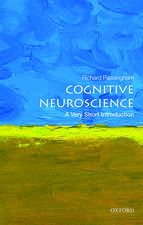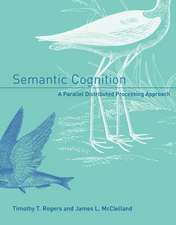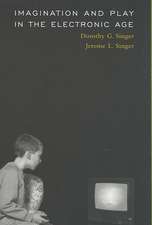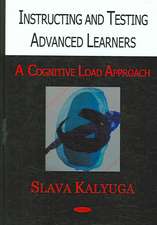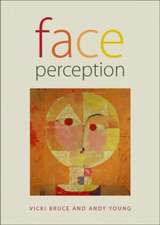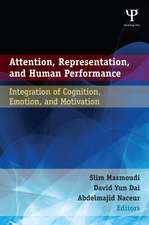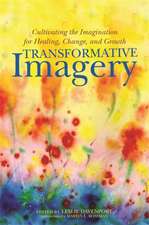Handbook of Imagination and Mental Simulation
Editat de Keith D. Markman, William M. P. Klein, Julie A. Suhren Limba Engleză Hardback – 15 dec 2008
This Handbook provides a novel and stimulating integration of work on imagination and mental simulation from a variety of perspectives. It is the first broad-based volume to integrate specific sub-areas such as mental imagery, imagination, thought flow, narrative transportation, fantasizing, and counterfactual thinking, which have, until now, been treated by researchers as disparate and orthogonal lines of inquiry. As such, the volume enlightens psychologists to the notion that a wide-range of mental simulation phenomena may actually share a commonality of underlying processes.
| Toate formatele și edițiile | Preț | Express |
|---|---|---|
| Paperback (1) | 507.55 lei 6-8 săpt. | |
| Taylor & Francis – 23 iun 2015 | 507.55 lei 6-8 săpt. | |
| Hardback (1) | 2083.97 lei 6-8 săpt. | |
| Taylor & Francis – 15 dec 2008 | 2083.97 lei 6-8 săpt. |
Preț: 2083.97 lei
Preț vechi: 2541.42 lei
-18% Nou
Puncte Express: 3126
Preț estimativ în valută:
398.77€ • 417.40$ • 331.90£
398.77€ • 417.40$ • 331.90£
Carte tipărită la comandă
Livrare economică 31 martie-14 aprilie
Preluare comenzi: 021 569.72.76
Specificații
ISBN-13: 9781841698878
ISBN-10: 1841698873
Pagini: 496
Ilustrații: 7 black & white tables
Dimensiuni: 178 x 254 x 30 mm
Greutate: 1.08 kg
Ediția:New.
Editura: Taylor & Francis
Colecția Psychology Press
Locul publicării:Oxford, United Kingdom
ISBN-10: 1841698873
Pagini: 496
Ilustrații: 7 black & white tables
Dimensiuni: 178 x 254 x 30 mm
Greutate: 1.08 kg
Ediția:New.
Editura: Taylor & Francis
Colecția Psychology Press
Locul publicării:Oxford, United Kingdom
Public țintă
PostgraduateCuprins
Part 1. The Mental Simulation of Action and Behavior. J. Decety, J. Stevens, Action Representation and its Role in Social Interactions. S. Beilock, I. Lyons, Expertise and the Mental Simulation of Action. S. Kosslyn, S. Moulton, Mental Imagery and Implicit Memory. E. Amit, D. Algom, Y. Trope, N. Liberman, Thou Shalt not Make Unto Thee any Graven Image: The Distance-Dependence of Representation. T. Faude, D. Wuerz, P. Gollwitzer, Implemental Intentions: The Mental Representation and Cognitive Procedures of IF-THEN Planning. Part 2. Mental Simulation and Memory. D. Bernstein, R. Godfrey, E. Loftus, False Memories: The Role of Plausibility and Autobiographical Belief. S. Lynn, S. Barnes, A. Matthews, Hypnosis and Memory: From Bernheim to the Present. K. Szpunar, K. McDermott, Episodic Future Thought: Remembering the Past to Imagine the Future. L. van Boven, J. Kane, A.P. McGraw, Temporally Asymmetric Constraints on Mental Simulation: Retrospection is more Constrained than Prospection. Part 3. Counterfactual Thinking: Simulating the Past. R. Byrne, V. Girotto, Cognitive Processes in Counterfactual Thinking. E. Wong, A. Galinsky, L. Kray, The Counterfactual Thinking Mind-Set: A Decade of Research. K. Markman, F. Karadogan, M. Lindberg, E. Zell, Counterfactual Thinking: Function and Dysfunction. Part 4. Alternatives and Alternate Selves. L. Sanna, N. Schwarz, L. Kennedy, It’s Hard to Imagine: Mental Simulation, Metacognitive Experiences, and the Success of Debiasing. M. Taylor, A.B. Shawber, A.M. Mannering, Children’s Imaginary Companions: What is it like to have an Imaginary Friend? E. Klinger, Daydreaming and Fantasizing: Thought Flow and Motivation. M. Green, J. Donahue, Simulated Worlds: Transportation into Narratives. Part 5. Perspective-Taking: Simulating Other Minds. R. Saxe, The Happiness of the Fish: Evidence for a Common Theory of One’s Own and Others’ Actions. C.D. Batson, Two Forms of Perspective Taking: Imagining How Another Feels and Imagining How You Would Feel. M. Myers, S. Hodges, Making it up and Making do: Simulation, Imagination, and Empathic Accuracy. N. Epley, E. Caruso, Perspective Taking: Misstepping into Others’ Shoes. Part 6. Simulating and Preparing For the Future. B. Klein, L. Zajac, Imagining a Rosy Future: The Psychology of Optimism. E. Dunn, N. Forrin, C. Ashton-James, On the Excessive Rationality of the Emotional Imagination: A Two Systems Account of Affective Forecasts and Experiences. E. Perunovic, A. Wilson, Subjective Proximity of Future Selves: Implications for Current Identity, Future Appraisal, and Goal Pursuit Motivation. L. Libby, R. Eibach, Seeing the Links Between the Personal Past, Present, and Future: How Imagery Perspective in Mental Simulation Functions in Defining the Temporally Extended Self. D. Oyserman, L. James, Possible Selves: From Content to Process. G. Oettingen, A. Kappes, Mental Contrasting of the Future and Reality to Master Negative Feedback. M. Zeelenberg, R. Pieters, On the Consequences of Mentally Simulating Future Forgone Outcomes: A Regret Regulation Perspective. P. Carroll, J. Shepperd, Preparedness, Mental Simulations, and Future Outlooks.
Notă biografică
Keith D. Markman is an Associate Professor of Psychology at Ohio University, where he a member of the Social Judgment and Behavioral Decision-Making program. Dr. Markman received his Ph.D. in 1994 at Indiana University and completed a three-year postdoctoral fellowship at the Ohio State University. He conducts research in the areas of counterfactual thinking, emotion and motivation, judgment and decision making, and psychological momentum, having published over 30 articles and book chapters in these areas. Dr. Markman is currently an associate editor of Basic and Applied Social Psychology and Social and Personality Psychology Compass. He was nominated for the 2003 Theoretical Innovation Prize in social and personality psychology and won the outstanding junior faculty award at Ohio University in 2004.
William M. P. Klein is an Associate Professor of Psychology at the University of Pittsburgh, where he is a member of the Social Psychology program and the Biological and Health Psychology program. He conducts research in the areas of social comparison, unrealistic optimism, risk perception, self-affirmation, ambiguity aversion, and health behavior, having published over 50 articles and chapters in these areas. Dr. Klein is a former co-editor of Psychology and Health and a recipient of the 2008 Chancellor’s Distinguished Teaching Award at the University of Pittsburgh.
Julie A. Suhr is an Associate Professor in the Department of Psychology at Ohio University. She completed her Ph.D. in Clinical Psychology in 1994 from the University of Iowa and completed a three-year postdoctoral fellowship in neuropsychology in the Department of Neurology at the University of Iowa College of Medicine, where her research work was funded by a National Research Service Award from the National Institutes of Aging. Her current research is focused on neuropsychological and psychological functioning in various neurological, neuropsychiatric, and medical disorders, and she is co-investigator on National Institutes of Health grants examining neuropsychological and psychophysiological effects of aging beliefs and stereotypes and neuropsychological factors associated with treatment for depression in individuals with HIV.
William M. P. Klein is an Associate Professor of Psychology at the University of Pittsburgh, where he is a member of the Social Psychology program and the Biological and Health Psychology program. He conducts research in the areas of social comparison, unrealistic optimism, risk perception, self-affirmation, ambiguity aversion, and health behavior, having published over 50 articles and chapters in these areas. Dr. Klein is a former co-editor of Psychology and Health and a recipient of the 2008 Chancellor’s Distinguished Teaching Award at the University of Pittsburgh.
Julie A. Suhr is an Associate Professor in the Department of Psychology at Ohio University. She completed her Ph.D. in Clinical Psychology in 1994 from the University of Iowa and completed a three-year postdoctoral fellowship in neuropsychology in the Department of Neurology at the University of Iowa College of Medicine, where her research work was funded by a National Research Service Award from the National Institutes of Aging. Her current research is focused on neuropsychological and psychological functioning in various neurological, neuropsychiatric, and medical disorders, and she is co-investigator on National Institutes of Health grants examining neuropsychological and psychophysiological effects of aging beliefs and stereotypes and neuropsychological factors associated with treatment for depression in individuals with HIV.
Recenzii
"This handbook is a marvelous resource of information that provides vital insights into human consciousness and mental life. The chapters provide a rich assortment of perspectives and fascinating lines of research. Written by influential, highly respected experts, the contributions to this volume together furnish a state-of-the-art overview of what the conscious human mind does when it moves away from the mundane here-and-now." - Roy F. Baumeister, Eppes Eminent Scholar and Professor of Psychology, Florida State University, USA, and author of The Cultural Animal: Human Nature, Meaning, and Social Life
"Mental simulation has evolved into a core theoretical idea spanning nearly all of psychology. Informing basic analyses of representation, imagery, metacognition, goals, fantasy, and behavior, the study of mental simulation is newly invigorated by insights from cognitive neuroscience. In this timely collection of essays, these diverse theoretical strands come together to shed new light on the mysteries of the human imagination." - Neal Roese, Professor of Psychology, University of Illinois, USA, and author of If Only
"Mental simulation has evolved into a core theoretical idea spanning nearly all of psychology. Informing basic analyses of representation, imagery, metacognition, goals, fantasy, and behavior, the study of mental simulation is newly invigorated by insights from cognitive neuroscience. In this timely collection of essays, these diverse theoretical strands come together to shed new light on the mysteries of the human imagination." - Neal Roese, Professor of Psychology, University of Illinois, USA, and author of If Only
Descriere
This Handbook provides a novel integration of work on imagination and mental simulation from a variety of perspectives. It is the first broad-based volume to integrate specific sub-areas such as mental imagery, imagination, thought flow, narrative transportation, fantasizing, and counterfactual thinking.

